Decorative Ideas for Wall Mount Guitars
Hanging a guitar on the wall is a great way to showcase your guitars and looks far better than using a guitar stand.
In this guide, I'll explain the different ways you can hang a guitar on the wall, how to avoid common mistakes, and the best wall hangers you can buy.
After you read this guide, check out my guide on Creating an Ideal Practice Space for inspiration on creating a great guitar room or practice area.
Types of Guitar Wall Mounts
Let's look at the different types of wall mounts you can use to hang your guitar on the wall. Understanding the different types of mounts will help you figure out how you would like to display your guitars.
Basic Wall Hangers
The most common type of wall mount is a basic wall hanger.
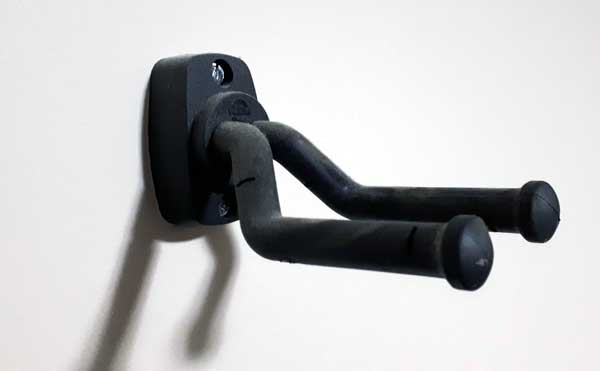
These wall hangers simply use two rods that stick out and hold your guitar's headstock in place.
These guitar wall hangers (link to Amazon) are the lowest-cost wall hangers you can buy and they work perfectly fine for most types of guitars.
I used this type of wall hanger to hang my guitar when I was a teenager and it still holds perfectly fine fifteen years later:
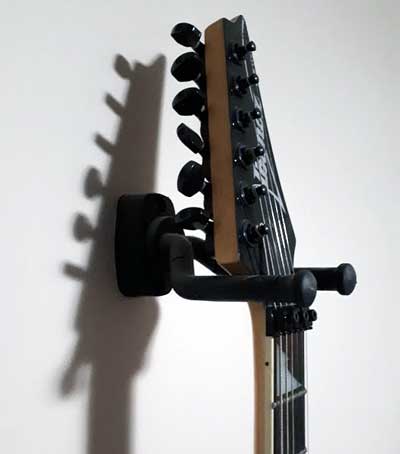
If you plan on hanging a lot of guitars, a low-cost hanger like this might suit you.
Some of these basic hangers are adjustable and you can change the width to suit your guitar. Others cannot be adjusted. If you want to hang a guitar with a wide neck such as a Classical acoustic guitar, be sure to check that the hanger will fit.
While almost all wall hangers should be strong enough to hold a guitar, I suggest avoiding the cheapest options available. Do you really want to trust the quality of a dirt-cheap hanger with your guitar just to save a couple of dollars? I bought some expensive wall mounts to give me peace of mind that my guitars will be safe.
Pros: these hangers are cheap and work well with most types of guitars.
Cons: some basic wall hangers will have trouble holding guitars properly such as the Telecaster.
Locking Wall Hangers
Locking wall hangers are an upgraded version of the above basic hangers. These hangers include a mechanism to lock the guitars in position.
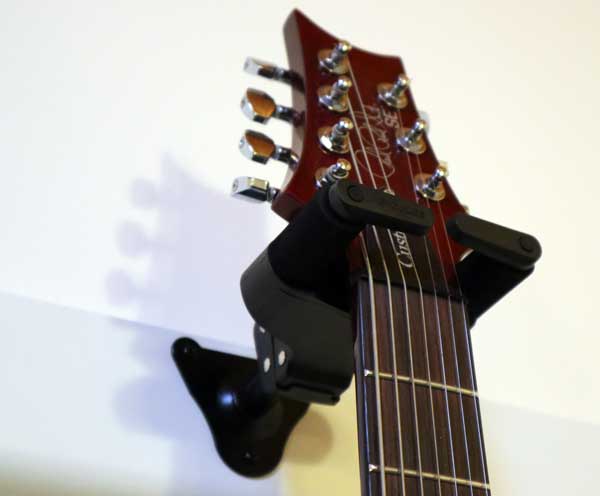
This is the type of hanger I used to hang all my guitars on my wall as you will see later.
There are a few brands to choose from, but the most popular is the range of Hercules guitar wall hangers.
The two models I recommend choosing between are the one with a wood wall bracket and the one with the metal wall bracket (I recommend the newer 'Plus' models).

The big advantage with these wall hangers is that they securely hold your guitar in a way that it won't get knocked out.
The newer models also include an attachment for narrow instrument necks, which means you can use these wall hangers easily for ukuleles or mandolins.
Pros: incredibly secure way of hanging a guitar to the wall. Able to hold a wide range of instrument sizes
Cons: more expensive than other options.
Horizontal or Angled Wall Mounts
While most wall hangers covered in this guide focus on hanging a guitar vertically, there are ways you can mount your guitar on an angle or horizontally.
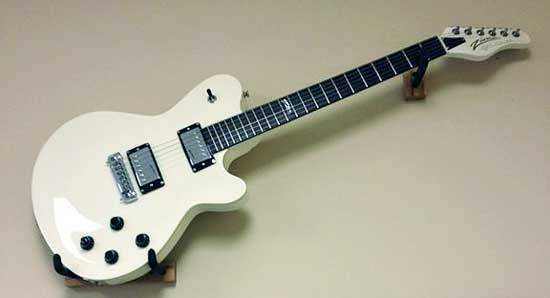
Mounting a guitar on an angle gives a lot of character to a room. It's a great way to decorate a room. If you only have one or two guitars, it looks fantastic when you line them all up on an angle.
The way these hangers work is that there's a hook that holds the upper section of the neck and another two hooks to hold the body of the guitar.
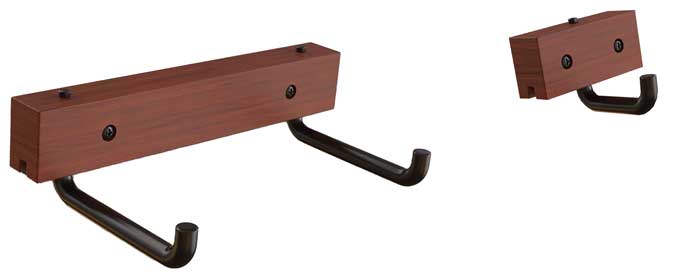
This horizontal or angled wall hanger kit (shown above) is suitable for electric or acoustic guitars and can be angled all way horizontally if you wanted.
Alternatively, if you want something a bit less visible, check out this guitar hanger that makes use of your guitar's strap buttons. The below guitars use this type of mount to achieve a clean look on the wall.
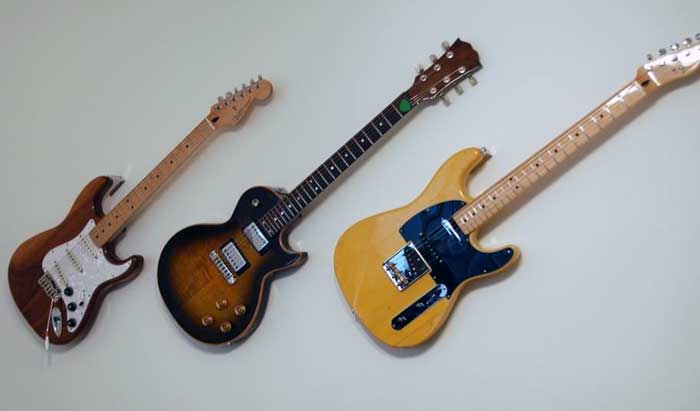
If you have a wide wall and only a few guitars to hang, consider hanging them on an angle.
Pros: looks fantastic and safely holds your guitars by spreading the weight over multiple anchor points.
Cons: takes up more wall space so may not be suitable for small rooms or when you have a lot of guitars.
3D Printed Hangers
The rise of 3D printer technology has opened up another way you can hang a guitar on the wall.
It's possible to print your own custom-designed hangers (or have somebody print one for you).

There are plenty of designs like the above examples you can freely download and print for your guitars.
Check out the website Thingiverse for freely downloadable designs.
If these are printed properly, they can be more than strong enough to securely hold your guitars.
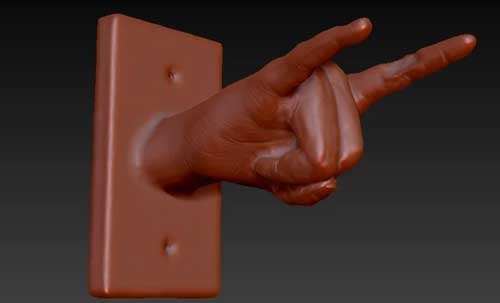
If you know how to create your own 3D designs (or know somebody who does), you can even create a custom hanger for your guitars.
If you don't know anybody with a 3D printer, there are websites you can use where you can pay people to print a design for you.
Pros: able to create completely custom hangers with interesting designs.
Cons: need a 3D printer or use a 3D printing service. If printed with the wrong settings, the hanger won't hold over time.
Boxes and Frames
All of the above options are relatively cheap and can look great on a wall.
But if you really want to showcase one or more of your guitars, framing or boxing it up in a display cabinet on the wall is the ultimate option.
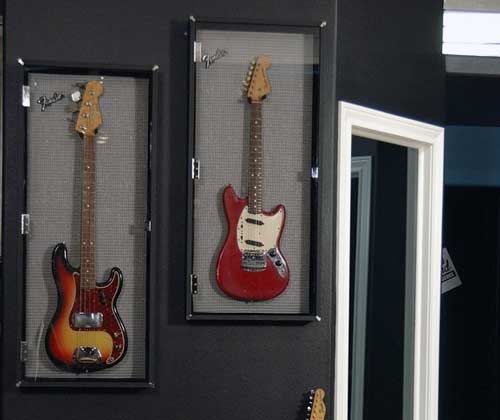
If you have good woodworking skills, this might be an option worth considering.
Some people build custom glass cabinets with special lighting, while others build a basic frame to go around a standard wall hanger.
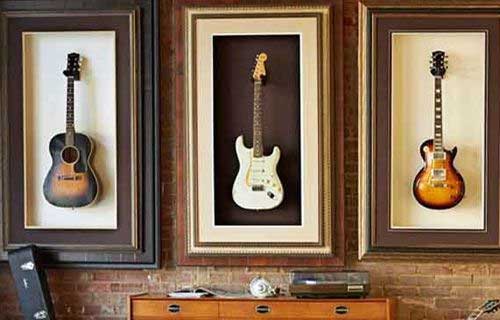
In the above photo, you can see how the guitars hang from a basic wall hanger as mentioned earlier. The only difference is that a custom frame surrounds the guitar.
Something like this is easy to build and can look impressive when it matches the rest of the room.
Pros: is an incredible way of showcasing a guitar on the wall.
Cons: requires decent woodworking skills to build and look good. Takes up a lot of wall space which may not suit you if you have a lot of guitars to hang or limited space.
Hanging a Guitar on Brick vs Studs vs Drywall
It is possible to securely hang a guitar on drywall, brick, or pretty much any other type of wall material.
Brick is the safest option as it creates an incredibly strong mount. If you want to mount your guitar on a brick wall, you'll need to drill into the brick and install appropriate mounting hardware.
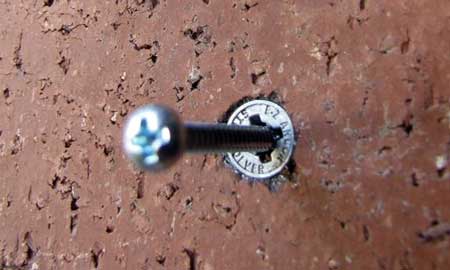
The Hercules wall mounts I bought included some brick mounting anchors. These plastic anchors push against the brick when you screw them in position, which creates an incredibly strong joint.
The next best option is mounting directly into wall studs.
If you can find the location of wall studs, I highly recommend mounting the hanger into them instead of into the drywall.
I'll explain how to find the location of studs later as this is the method I used to hang my guitars.
The least secure option is mounting directly into drywall.
It is possible to securely hang a guitar directly into drywall. But there are plenty of horror stories of guitars falling or ripping holes in the wall.
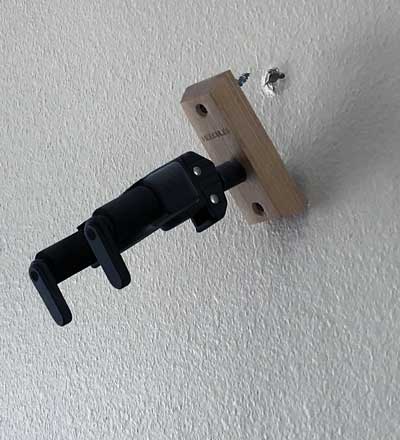
While something like the above photo is possible when mounting directly into drywall, it's not going to happen when mounting into wall studs or brick.
A properly-installed wall hanger can support the weight of your guitar (learn about guitar weight here).
The problem is that mounting a guitar isn't the same as mounting a big painting or wall hanging because the guitar is added and removed from the wall over and over.
Every time you put your guitar back on the wall, it stresses the joint due to the shift in weight. This can degrade the strength of the drywall over time.
Imagine standing on bathroom scales and lightly jumping up and down. You'll see the scales fluctuate well above what you actually weigh.

As you lightly jump down on the scales, you're applying more force than your normal weight.
A similar thing happens when you hang your guitar on the wall. As you lower it into the hanger, you're applying more force than the normal weight of the guitar.
This is why some wall hangers can suddenly fail after a long time of working fine. The gradual wear and tear weaken the mount.
I highly recommend mounting your hanger directly into brick or wall studs. If this isn't possible, make sure you use appropriate drywall mounting hardware and be gentle with your guitar on the wall.
Almost all negative reviews you see online for wall hangers that failed were due to bad mounting on drywall or stressing the mount too much over time.
A decent-quality guitar hanger should never fail. It's the drywall around the screws that can fail.
Step-by-Step Instructions to Hang a Guitar on the Wall
Let's go through a step-by-step method for hanging a guitar on the wall.
While this can be as simple as screwing the hanger into the wall, there are some things you should carefully consider before you start.
Step 1: Find Suitable Wall Locations
The first step is to find a suitable location to hang your guitar.
Here are some basic tips for finding a suitable wall:
- Make sure there is plenty of space around the guitar
- Avoid walls where people are likely to bump into the guitar (the guitar will stick out from the wall)
- Find a location where you can easily reach the guitar
- Consider walls where you have space to add more guitars in the future
- Avoid walls that get direct sunlight
If you only want to hang one guitar on the wall, you'll be able to find plenty of suitable locations.
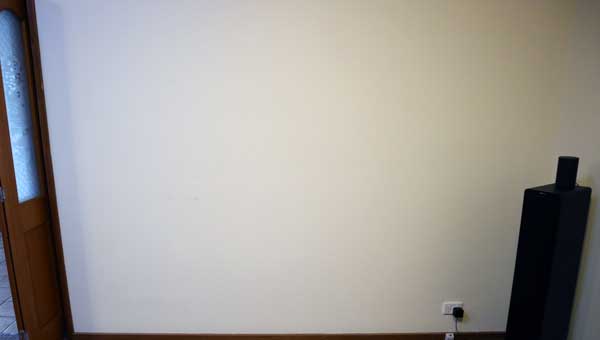
If you want to hang multiple guitars, you'll have fewer options and need to carefully plan the layout before you start.
Step 2: Decide on Hanging Style
Decide whether you want to hang your guitar vertically, at an angle, or horizontally.
Whether you play acoustic or electric guitar, there are hangers and mounts suitable for all hanging styles, so think about how you want to display your guitar.
Hold your guitar up on the wall to get an idea of how it would look vertically, at an angle, or horizontally.
Get somebody else to hold the guitar up on the wall so you can see how it looks from different positions.
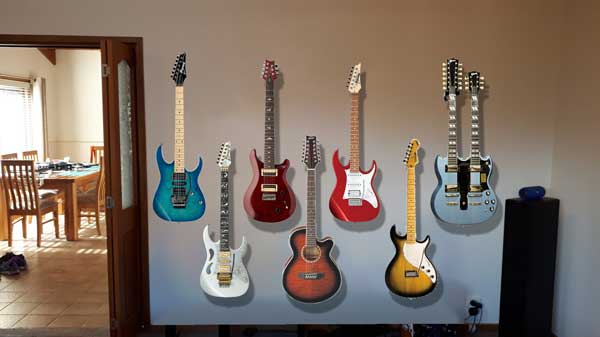
As I planned to mount a lot of guitars on my wall, I created a rough mockup in Photoshop to see how they would look in different arrangements. If you're only planning on hanging one or two guitars, this will be overkill.
Once you have decided on how you want to hang your guitar, you'll be able to find a suitable mount to buy as covered earlier. Don't buy a hanger until you've found a suitable location and are happy with the hanging style you want to use.
Step 3: Decide on Height and Position
Once you mount your guitar, you probably won't be changing the position, so it's worth thinking about the mounting height now.
Here are some things to consider:
- How much space does the guitar leave beneath it? (eg: can you sit your guitar amp directly under your guitar?)
- Can you easily reach the guitar?
- Is the guitar within reach of small children? (if relevant)
- Do you have room to add another guitar to the wall later if you want to?
Once you decide on a suitable height, consider the position.
The best position for your guitar depends on the style you want and the type of wall.
As mentioned earlier, a brick wall is the strongest, followed by mounting into wall studs, followed by drywall.
Step 4: Find Possible Wall Studs
If you want to hang your guitar on drywall, first check to see if there are any wall studs you could use.
To check if the wall has studs in the location you want to hang your guitar, lightly tap your knuckles against the wall, and slowly move across the wall. Listen to the sound.
The sound will change from a hollow thud to a solid thud when you reach a stud location.
If it sounds like there is a stud in the approximate location you want to mount your guitar, use a stud finder like this one to pinpoint the location.
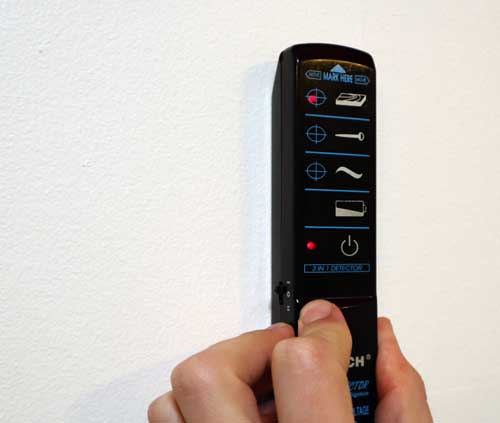
Stud finders work extremely well (even the ancient one I used) and will give you peace of mind knowing that you're hanging your guitar in a secure location.
Stud finders also ensure you avoid drilling into your house wiring or other important cables.
Lightly mark the location of the stud using a pencil, then mark the height you want to mount your hanger.
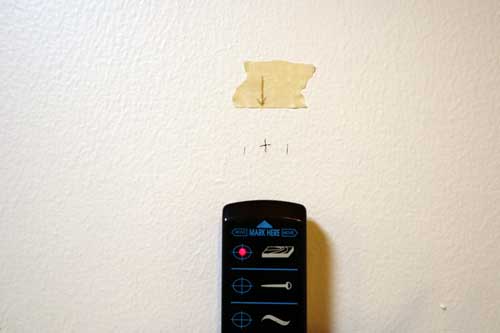
Go over this measurement a few times to make sure the stud finder is accurately finding the position of the stud.
(Optional) Spacing Multiple Guitars
If you want to mount multiple guitars on your wall, it's important to plan for the spacing between each guitar.
Lay all the guitars on the floor so you can get an idea of the minimum space you need between each one.
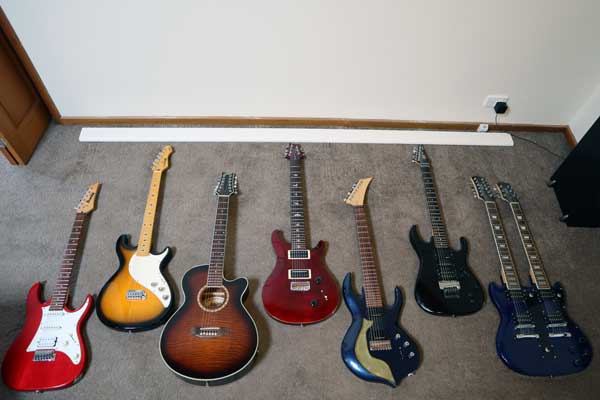
I wanted to mount seven guitars on my wall, which obviously takes up a lot of space.
The wall space I have isn't long enough for all of the guitars to line up in a row, but they can easily fit if staggered in two rows.
Whether you want to hang your guitars vertically, at an angle, or horizontally, take the time to think about the spacing before you mount any hangers.
I decided to mount all of the guitars on horizontal boards of wood, then mount that wood to the wall.
The advantage of doing this is that you can mount the wood board directly into multiple wall studs. This creates an incredibly strong mounting surface and evenly spreads the weight of the guitars across multiple studs.

You can see that the first board has been mounted onto six wall studs. This creates a ridiculously strong mounting surface for the hangers.
If I didn't use a mounting board, some of the guitars would have lined up with wall studs and others would have to be mounted directly into the drywall.
If you want to mount multiple guitars vertically, I highly recommend using a mounting board.
Step 4: Mount the Hanger
Once you're happy with the location you want to hang your guitar, you can mount the hanger.
I mounted the hangers into a mounting board, but you can follow the main steps whether you're mounting in drywall, wall studs, or brick walls.
First, line up the mount in position and mark the position of the holes.
Depending on the hanger, try to use a spirit level to keep the hanger straight.
If you're mounting a guitar on an angle, mount the main body bracket first, then after it has been mounted, you can find the correct position for the neck bracket.

I marked the screw positions for my hanger by pressing the screws hard into the holes so they would create an indent into the mounting board. Alternatively, you can use a pencil.
With the hole positions marked, drill a suitable size hole for the screw.
If you're mounting into brick, match the drill bit to the size of the anchor you'll be using.
If you're mounting into wall studs, match the drill bit to be slightly thinner than the screw size. If the drill bit is too wide, the screw won't grab the wood properly. If the drill bit is too narrow, the wood may split.
If you're mounting directly into drywall, match the drill bit to the size appropriate for the anchor you're using.
Next, position the hanger and add the screws.
The hanger I used is quite bulky, so it got in the way of the drill. I had to use a screwdriver to drive the screws into the wall.

If you can't drive the screws in past a certain point, it means the drilled hole is too narrow.
You should end up with the screw being tough but not impossible to drive all the way to the end.
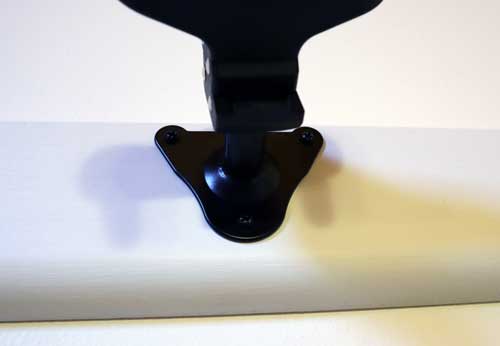
Once all the mounting screws are secured in position, carefully place your guitar on the hanger.
Pay close attention to any sounds such as cracking. I highly doubt you'll have problems if you installed the hanger properly, but if you're hanging a heavy guitar, pay extra attention to any signs of weakness.
How to Mount Multiple Guitars on the Wall
If you want to mount multiple guitars on the wall, you have a few different options.
You can mount them individually as shown below:

All sorts of arrangements are possible such as lined up horizontally, staggered, in rows, or angled.
Pros: looks great and you have freedom over how to arrange your guitars.
Cons: you may have to rely on mounting directly into drywall for some guitars, which won't be as secure
Alternately, you can mount a board to the wall and mount the hangers onto that board.
This is what I did for the strongest way to spread the weight of all of my guitars across the wall.

Pros: evenly spread the weight of multiple guitars across the wall. Creates a stronger mount
Cons: Restricts the way you can arrange your guitars. Doesn't look as good as other options.
Here are some tips if you want to mount multiple guitars on a wall:
- Try to evenly space the guitars
- Make sure there is enough space between guitars before you install the mounts
- Make use of wall studs for a stronger mount
- Use a pencil to plan and mark all the positions before you mount any hangers
With my guitars, I wanted to mount seven guitars staggered across two levels.
To do this, I first worked out the spacing between the guitars by laying them flat on the floor.

Then I painted and mounted the two backing boards based on how far apart I wanted the two levels.
Laying the guitars on the floor will give you a good idea on how they will look on the wall. You can easily adjust the height between the levels to see what works and what doesn't.
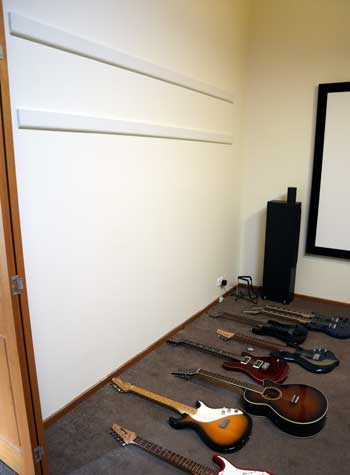
Be absolutely sure you're happy with the heights and distance between the two levels before you mount the boards. You definitely don't want to get to the last guitar and realize you don't have enough space.
Then I started by mounting the middle guitar in the center of the board.
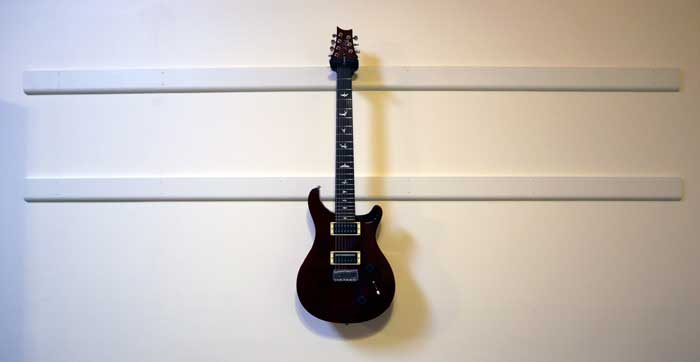
This is to ensure that I would evenly space the guitars across the board. If you have an odd number of guitars to mount, starting with the middle guitar will avoid the problem of running out of room on one side.
If you're mounting an even number of guitars, start from the edges and work your way in.
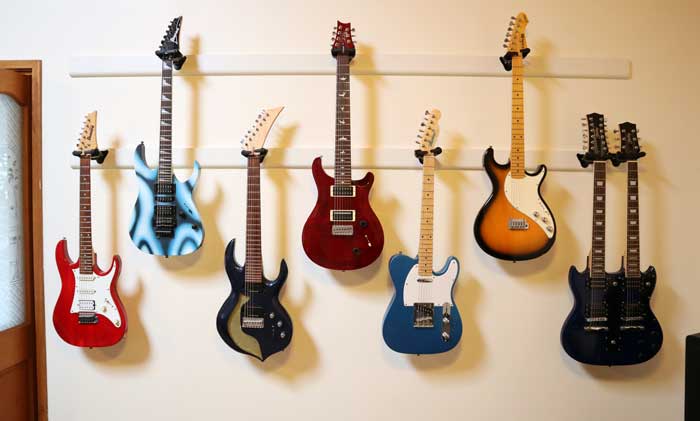
The end result will be evenly spaced guitars. Take your time planning and marking positions to avoid problems later on.
Hang a Guitar on the Wall FAQ
Here are some common questions you might have about hanging a guitar on your wall.
Can You Hang a Guitar on Drywall?
Yes, you can hang a guitar safely on drywall if you use suitable drywall anchors. When suitable drywall anchors are installed, they provide more than enough support for the weight of a guitar.
As explained earlier in this guide, most issues when hanging a guitar on drywall is due to poorly installed mounts.
Is it Bad to Hang a Guitar on the Wall?
It is perfectly fine to hang a guitar on the wall. If the guitar mount is installed properly, the guitar won't fall. The force on the neck from hanging the guitar won't cause problems.
Keep in mind that the tension created from the guitar strings is significantly higher than the force created from hanging the guitar by the headstock. So hanging the guitar by the headstock isn't bad for it.
What is the Best Guitar Wall Hanger?
The locking guitar wall hangers by Hercules are some of the best available. Any wall hanger that securely holds your guitar while providing padding to the neck is worth considering.
Keep in mind that the best wall hanger for you depends on your budget and how you want to display your guitar. For some guitarists, a locking wall hanger like the Hercules branded hangers are overkill.
How do you Hang a Ukulele on the Wall?
You hang a Ukulele on the wall in the same way you hang a guitar. You can even use a standard guitar hanger if it uses an adjustable space.
The hangers I used included inserts to allow you to hang ukuleles, mandolins and any other instrument with a thin neck.
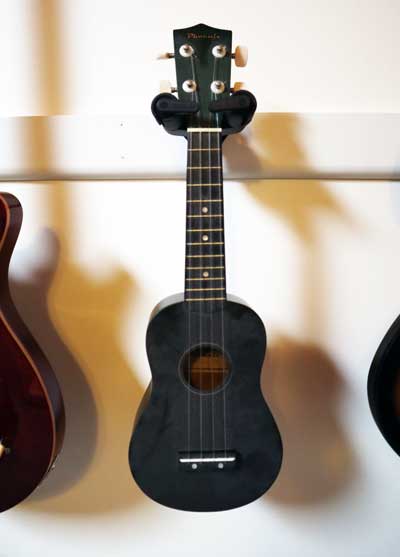
There are many other ways to hang a ukulele on the wall as they're incredibly light and don't require heavy-duty mounting hardware.
Are Wall Hangers Bad for Guitar?
Wall hangers are not bad for guitars. The weight of the guitar does not cause enough strain on the neck to cause any damage. You can safely use any sturdy wall hanger and it will not damage your guitar.
Wall hangers are safe to use if you correctly mount them to the wall. The only time a wall hanger can be bad for a guitar is if it isn't mounted properly and causes the guitar to fall. If you follow the advice in this guide, your guitar will be safe.
Should Guitars be Stored Flat?
Guitars can safely be stored flat in a case, on a stand, in a rack, or hanging on a wall. Some guitars cannot be stored flat due to an angled headstock.
If you want more examples of different ways to decorate or style your guitar room, check out this guide on How to Create an Ideal Practice Space.
The guide includes some great examples of other guitarists' practice spaces you can use for ideas.

Related Guides and Lessons:
Decorative Ideas for Wall Mount Guitars
Source: https://guitargearfinder.com/guides/hang-guitar-on-wall/